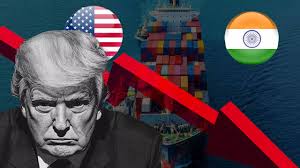
President Donald Trump’s surprise announcement on Truth Social that the United States will levy a 25 percent tariff on all Indian imports beginning August 1 has sent shockwaves through both governments’ trade teams. The move comes just as negotiators in Washington and New Delhi had been working toward a limited framework agreement, aimed at easing farm, dairy and industrial access. By coupling the tariff levy with unspecified penalties over India’s purchases of Russian energy and military equipment, the administration has dramatically raised the stakes—potentially unraveling months of progress and threatening to sour the broader U.S.–India strategic partnership.
Tariff Shock Amid Ongoing Negotiations
Talks had been under way for several months, with U.S. negotiators pressing for Indian tariff cuts on products such as wheat, corn, rice and genetically modified soybeans. India, in turn, resisted sweeping reductions that could imperil millions of smallholder farmers. The tariff announcement abruptly shifted leverage back to Washington, signaling that the administration is willing to use unilateral measures to extract concessions. Indian commerce officials, caught off guard by the timing, have warned that the sudden imposition could breach World Trade Organization rules and prompt a formal dispute settlement case. New Delhi has also indicated it may retaliate with its own duties on U.S. goods, further undermining the fragile path to a negotiated deal.
Beyond the WTO dispute potential, the tariff shock is likely to stall any interim agreements already drafted. Senior Indian officials had expressed optimism that a so‑called “phase one” accord could be finalized by autumn, expanding bilateral trade from $191 billion in 2024 to $500 billion by 2030. With the clock ticking—August 1 is only days away—text of the expected interim pact, which would have addressed nontariff barriers and regulatory cooperation, will now require substantial renegotiation. U.S. farm lobbies, eager for access to India’s large dairy and grain markets, are watching nervously as the prospect of retaliatory Indian tariffs on products such as pulses and sugar looms.
Sectoral and Supply‑Chain Disruptions
Indian exporters in labour‑intensive sectors are bracing for an immediate hit. The garments and textile industry—responsible for some $8 billion of exports to the U.S.—stands to lose market share as U.S. importers either absorb higher costs or shift orders to competing suppliers in Bangladesh or Vietnam. Pharmaceutical companies, which export $4 billion in generics annually, may face delays in approvals for price adjustments, squeezing profit margins. Small gem and jewelry traders, long reliant on duty‑free access for cut diamonds, warn that a quarter‑point levy could render many shipments uneconomical. Meanwhile, petrochemical firms exporting plastics and resins dread a drop in orders as U.S. manufacturers seek alternative feedstocks at lower tariff rates.
Supply‑chain managers on both sides are already recalibrating. U.S. retailers are exploring regional sourcing partnerships in Southeast Asia, while Indian manufacturers are accelerating diversification toward European and African markets. Shipping lines and port operators anticipate a slowdown in container volumes through Oakland and New York, potentially leading to blank sailings. Cancellation of backlog orders—some dating from negotiations in June—threatens to leave Indian factories with unsold inventory, forcing cutbacks in production and worker hours. On the flip side, U.S. importers of Indian spices, rice and processed foods may pass costs to consumers or absorb them temporarily, testing retail margins and consumer price sensitivity.
Geopolitical and Strategic Fallout
The tariffs have also injected new tension into what was shaping up as a deepening U.S.–India strategic partnership, anchored by counter‑China cooperation and shared concerns over security in the Indo-Pacific. India’s recent defense procurements from Russia and energy imports have been cited by the White House as justification—but New Delhi argues that its policy space on strategic autonomy, agriculture and digital governance must be respected. Diplomatic sources suggest that Prime Minister Narendra Modi’s government may respond by delaying planned joint military exercises or reevaluating intelligence‑sharing arrangements, though outright suspension of strategic ties remains unlikely.
Global allies and multilateral institutions are watching closely. The G20 and WTO may be called upon to mediate or at least issue statements urging both sides back to the negotiating table. The European Union and Japan—both recent beneficiaries of U.S. tariff relief under Trump’s “Liberation Day” deals—stand to gain if India redirects trade toward those markets. Beijing, in turn, could capitalize by deepening its own investment and trade outreach in New Delhi, potentially undercutting U.S. influence. If India does retaliate outside the WTO framework, it could trigger a wider cascade of tariff hikes among key emerging economies.
Financial markets reacted swiftly. India’s benchmark stock indices dipped more than one percent on the tariff news, while the rupee slid against the dollar. Analysts at leading brokerage houses trimmed their 2025 export growth forecasts by up to 1.5 percentage points, citing the U.S. as India’s largest single‑country export destination. On Wall Street, shares of major U.S. retailers and multinational corporations with large exposure to Indian sourcing saw minor declines, reflecting investor concerns over supply‑chain cost pressures and potential margin squeezes.
In the immediate term, business communities on both sides will lobby intensively. The U.S. Chamber of Commerce and National Association of Manufacturers are expected to press the administration for exemptions or phased implementation, citing the risk of inflationary pass‑through to consumers. Indian industry associations, such as the Confederation of Indian Industry and Federation of Indian Export Organisations, will seek diplomatic intervention from other friendly capitals, hoping to build a coalition in support of rolling back the tariff decision. Meanwhile, legal teams are preparing briefs for possible WTO litigation—a process that could take years to resolve.
Ultimately, the implications of the 25 percent tariff extend well beyond customs duties. They threaten to derail a landmark trade accord, destabilize key manufacturing and agricultural sectors, and inject fresh strain into a critical geopolitical partnership. For exporters and policymakers on both sides, the coming weeks will be a test of resolve, strategy and the capacity to distinguish tactical pressure from strategic cooperation in 21st‑century trade relations.
(Source:www.bloomberg.com)
Tariff Shock Amid Ongoing Negotiations
Talks had been under way for several months, with U.S. negotiators pressing for Indian tariff cuts on products such as wheat, corn, rice and genetically modified soybeans. India, in turn, resisted sweeping reductions that could imperil millions of smallholder farmers. The tariff announcement abruptly shifted leverage back to Washington, signaling that the administration is willing to use unilateral measures to extract concessions. Indian commerce officials, caught off guard by the timing, have warned that the sudden imposition could breach World Trade Organization rules and prompt a formal dispute settlement case. New Delhi has also indicated it may retaliate with its own duties on U.S. goods, further undermining the fragile path to a negotiated deal.
Beyond the WTO dispute potential, the tariff shock is likely to stall any interim agreements already drafted. Senior Indian officials had expressed optimism that a so‑called “phase one” accord could be finalized by autumn, expanding bilateral trade from $191 billion in 2024 to $500 billion by 2030. With the clock ticking—August 1 is only days away—text of the expected interim pact, which would have addressed nontariff barriers and regulatory cooperation, will now require substantial renegotiation. U.S. farm lobbies, eager for access to India’s large dairy and grain markets, are watching nervously as the prospect of retaliatory Indian tariffs on products such as pulses and sugar looms.
Sectoral and Supply‑Chain Disruptions
Indian exporters in labour‑intensive sectors are bracing for an immediate hit. The garments and textile industry—responsible for some $8 billion of exports to the U.S.—stands to lose market share as U.S. importers either absorb higher costs or shift orders to competing suppliers in Bangladesh or Vietnam. Pharmaceutical companies, which export $4 billion in generics annually, may face delays in approvals for price adjustments, squeezing profit margins. Small gem and jewelry traders, long reliant on duty‑free access for cut diamonds, warn that a quarter‑point levy could render many shipments uneconomical. Meanwhile, petrochemical firms exporting plastics and resins dread a drop in orders as U.S. manufacturers seek alternative feedstocks at lower tariff rates.
Supply‑chain managers on both sides are already recalibrating. U.S. retailers are exploring regional sourcing partnerships in Southeast Asia, while Indian manufacturers are accelerating diversification toward European and African markets. Shipping lines and port operators anticipate a slowdown in container volumes through Oakland and New York, potentially leading to blank sailings. Cancellation of backlog orders—some dating from negotiations in June—threatens to leave Indian factories with unsold inventory, forcing cutbacks in production and worker hours. On the flip side, U.S. importers of Indian spices, rice and processed foods may pass costs to consumers or absorb them temporarily, testing retail margins and consumer price sensitivity.
Geopolitical and Strategic Fallout
The tariffs have also injected new tension into what was shaping up as a deepening U.S.–India strategic partnership, anchored by counter‑China cooperation and shared concerns over security in the Indo-Pacific. India’s recent defense procurements from Russia and energy imports have been cited by the White House as justification—but New Delhi argues that its policy space on strategic autonomy, agriculture and digital governance must be respected. Diplomatic sources suggest that Prime Minister Narendra Modi’s government may respond by delaying planned joint military exercises or reevaluating intelligence‑sharing arrangements, though outright suspension of strategic ties remains unlikely.
Global allies and multilateral institutions are watching closely. The G20 and WTO may be called upon to mediate or at least issue statements urging both sides back to the negotiating table. The European Union and Japan—both recent beneficiaries of U.S. tariff relief under Trump’s “Liberation Day” deals—stand to gain if India redirects trade toward those markets. Beijing, in turn, could capitalize by deepening its own investment and trade outreach in New Delhi, potentially undercutting U.S. influence. If India does retaliate outside the WTO framework, it could trigger a wider cascade of tariff hikes among key emerging economies.
Financial markets reacted swiftly. India’s benchmark stock indices dipped more than one percent on the tariff news, while the rupee slid against the dollar. Analysts at leading brokerage houses trimmed their 2025 export growth forecasts by up to 1.5 percentage points, citing the U.S. as India’s largest single‑country export destination. On Wall Street, shares of major U.S. retailers and multinational corporations with large exposure to Indian sourcing saw minor declines, reflecting investor concerns over supply‑chain cost pressures and potential margin squeezes.
In the immediate term, business communities on both sides will lobby intensively. The U.S. Chamber of Commerce and National Association of Manufacturers are expected to press the administration for exemptions or phased implementation, citing the risk of inflationary pass‑through to consumers. Indian industry associations, such as the Confederation of Indian Industry and Federation of Indian Export Organisations, will seek diplomatic intervention from other friendly capitals, hoping to build a coalition in support of rolling back the tariff decision. Meanwhile, legal teams are preparing briefs for possible WTO litigation—a process that could take years to resolve.
Ultimately, the implications of the 25 percent tariff extend well beyond customs duties. They threaten to derail a landmark trade accord, destabilize key manufacturing and agricultural sectors, and inject fresh strain into a critical geopolitical partnership. For exporters and policymakers on both sides, the coming weeks will be a test of resolve, strategy and the capacity to distinguish tactical pressure from strategic cooperation in 21st‑century trade relations.
(Source:www.bloomberg.com)





